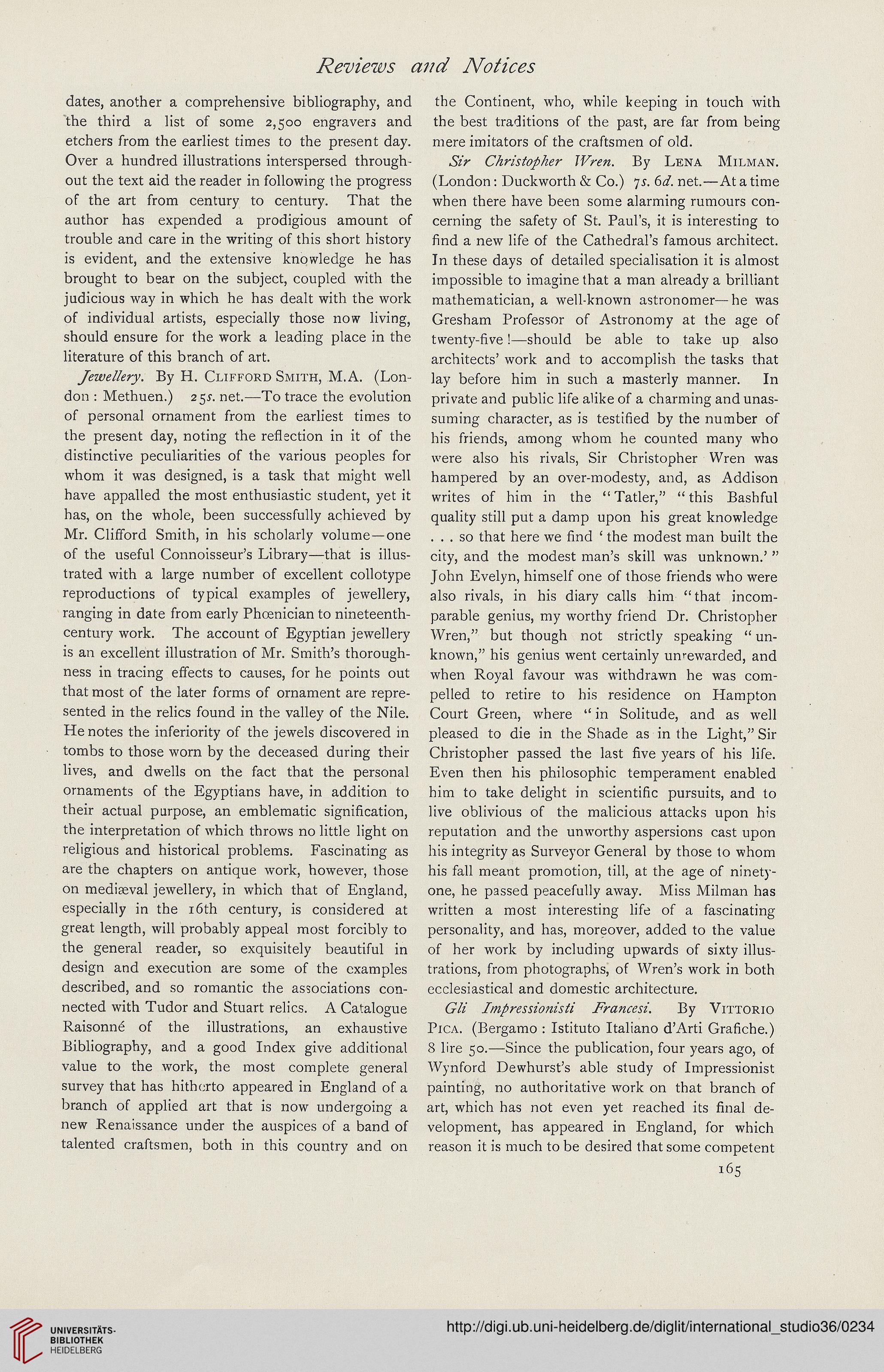dates, another a comprehensive bibliography, and
the third a list of some 2,500 engravers and
etchers from the eariiest times to the present day.
Over a hundred iilustrations interspersed through-
out the text aid the reader in foiiowing the progress
of the art from century to century. That the
author has expended a prodigious amount of
troubie and care in the writing of this short history
is evident, and the extensive knowiedge he has
brought to bear on the subject, coupied with the
judicious way in which he has dealt with the work
of individuai artists, especiaiiy those now iiving,
shouid ensure for the work a ieading piace in the
iiterature of this branch of art.
_/<:KV<%7y. By H. CLIFFORDSMITH, M.A. (Lon-
don : Methuen.) 25L net.—To trace the evolution
of personai ornament from the eariiest times to
the present day, noting the refiection in it of the
distinctive peculiarities of the various peoples for
whom it was designed, is a task that might weli
have appaiied the most enthusiastic student, yet it
has, on the whole, been successfuliy achieved by
Mr. Ciifford Smith, in his schoiariy voiume—one
of the usefui Connoisseur's Library—that is iilus-
trated with a large number of excelient coilotype
reproductions of typicai exampies of jeweliery,
ranging in date from eariy Phoenician to nineteenth-
century work. The account of Egyptian jeweiiery
is an exceiient iiiustration of Mr. Smith's thorough-
ness in tracing effects to causes, for he points out
that most of the iater forms of ornament are repre-
sented in the reiics found in the vaiiey of the Niie.
He notes the inferiority of the jeweis discovered in
tombs to those worn by the deceased during their
lives, and dweiis on the fact that the personai
ornaments of the Egyptians have, in addition to
their actuai purpose, an emblematic signihcation,
the interpretation of which throws no iittie iight on
religious and historical probiems. Fascinating as
are the chapters on antique work, however, those
on medisevai jeweiiery, in which that of England,
especially in the 16th century, is considered at
great length, will probably appeal most forcibly to
the general reader, so exquisitely beautiful in
design and execution are some of the cxamples
described, and so romantic the associations con-
nected with Tudor and Stuart relics. A Catalogue
Raisonne of the illustrations, an exhaustive
Bibliography, and a good Index give additional
value to the work, the most complete general
survey that has hithcrto appeared in England of a
branch of applied art that is now undergoing a
new Renaissance under the auspices of a band of
talented craftsmen, both in this country and on
the Continent, who, while keeping in touch with
the best traditions of the past, are far from being
mereimitators of the craftsmen of old.
-S27- C/%7-A^;%C7* IfT-r'72. By LENA MlLMAN.
(London: Duckworth & Co.) 7$. 6<f. net.—At a time
when there have been some alarming rumours con-
cerning the safety of St. Paul's, it is interesting to
find a new life of the Cathedral's famous architect.
In these days of detailed specialisation it is almost
impossible to imagine that a man already a brilliant
mathematician, a well-known astronomer—he was
Gresham Professor of Astronomy at the age of
twenty-hve!—should be able to take up also
architects' work and to accomplish the tasks that
lay before him in such a masterly manner. In
private and public life alike of a charming and unas-
suming character, as is testihed by the number of
his friends, among whom he counted many who
were also his rivals, Sir Christopher Wren was
hampered by an over-modesty, and, as Addison
writes of him in the "Tatler," "this Bashful
quality still put a damp upon his great knowledge
. . . so that here we hnd ' the modest man built the
city, and the modest man's skill was unknown.' "
John Evelyn, himself one of those friends who were
also rivals, in his diary calls him " that incom-
parable genius, my worthy friend Dr. Christopher
Wren," but though not strictly speaking " un-
known," his genius went certainly umewarded, and
when Royal favour was withdrawn he was com-
pelled to retire to his residence on Hampton
Court Green, where " in Solitude, and as well
pleased to die in the Shade as in the Light," Sir
Christopher passed the last hve years of his life.
Even then his philosophic temperament enabled
him to take delight in scientihc pursuits, and to
live oblivious of the malicious attacks upon his
reputation and the unworthy aspersions cast upon
his integrity as Surveyor General by those to whom
his fall meant promotion, till, at the age of ninety-
one, he passed peacefully away. Miss Milman has
written a most interesting life of a fascinating
personality, and has, moreover, added to the value
of her work by including upwards of sixty illus-
trations, from photographs, of Wren's work in both
ecclesiastical and domestic architecture.
Aw/T-MJMTzAZf ^7-<272rM2'. By VlTTORtO
PiCA. (Bergamo : Istituto Italiano d'Arti Grafiche.)
8 lire 50.—Since the publication, four years ago, of
Wynford Dewhurst's able study of Impressionist
painting, no authoritative work on that branch of
art, which has not even yet reached its final de-
velopment, has appeared in England, for which
reason it is much to be desired that some competent
165





